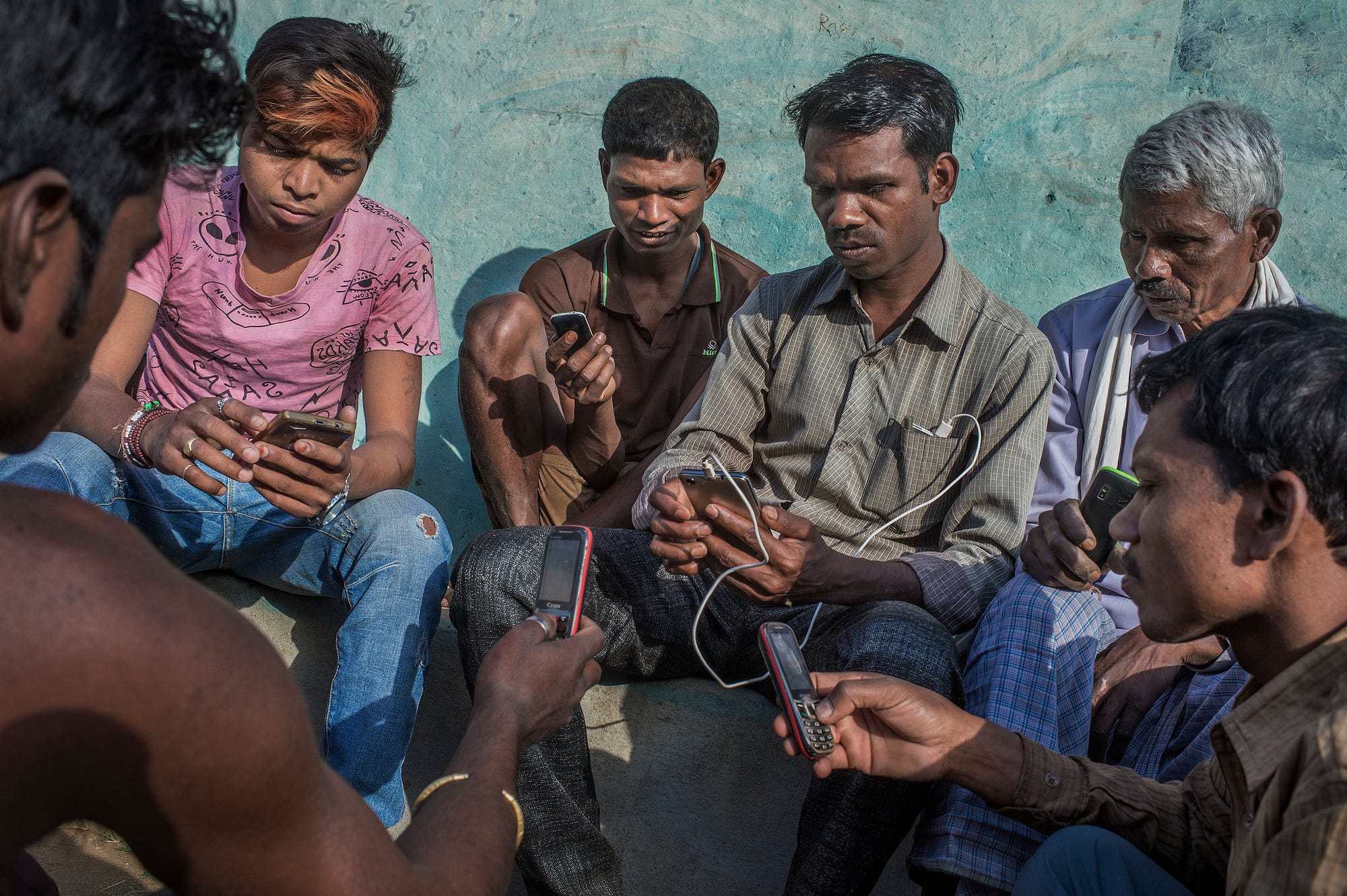Heads Down, Profits Up: How Your Obsession With Phone Is Making Others Rich?
Are we fully aware of how much our digital habits are shaping not just entertainment and business but the very fabric of our society? Are we the consumers of content, or is content consuming us? Are we citizens with smartphones, or are we increasingly becoming smartphone appendages with citizenship?"

Have you ever looked at a family sitting at a table in a restaurant and wondered if they know each other? Grandparents, parents and children sat there, their smartphone displays lit up with a soft blue light, heads bowed and seemingly gazing with solemn devotion at the digital gods.
Welcome to modern India, where the nationwide religion of smartphone worship is being practiced with unprecedented devotion, and the collection plate is being passed around by tech companies, content creators, and politicians who are laughing all the way to the bank.
In a country where economic analysts twist their hands over slowdowns in consumer spending and point accusing fingers at government policies, there’s one sector where Indians continue to invest with reckless abandon, and that is called “digital consumption”.
While the nation’s growth is projected to hit a 4-year low, Indians have collectively spent a staggering 1.1 lakh crore hours staring at their smartphone screens in 2024 alone.
That’s not a typo—1.1 LAKH CRORE hours. If time were currency, we’d be the richest nation on Earth. Unfortunately, in this case, our time is quite literally becoming other people’s money.

The average Indian now spends approximately 5 hours daily on their mobile screen, with nearly 70% of that time devoted to the holy trinity of modern distraction of social media platforms, gaming, and video content. This digital devotion has transformed the landscape of India’s entertainment industry, with digital channels now representing the single largest segment of the country’s 2.5 lakh crore rupees ($29.1 billion) media and entertainment industry in 2024. Television, that once-dominant force that brought families together in living rooms across the nation, has been dethroned, relegated to background noise while we scroll through Instagram reels of people showing us how to brush our teeth properly—because apparently, we needed help with that.
Similar examples from the past!
This phenomenon isn’t exactly new in human history. Throughout time, people have been caught as prey by the latest technologies. Take the example of ancient Rome, where citizens were so obsessed by chariot races and gladiatorial games that the Emperor Juvenal lamented the populace’s obsession with “bread and circuses,” neglecting civic responsibilities for entertainment. During the 17th and 18th centuries, coffee houses in Europe became so popular that rulers worried about the political discussions happening within them, with King Charles II of England even attempting to ban them in 1675.
The introduction of newspapers, radio, television—each technological advance has brought with it concerns about obsession and distraction. But none has been quite so intimately personal, so constantly present, or so comprehensively monetized as the smartphone.
When the telephone was first introduced to India in 1882, it was an elite luxury, with just a few hundred connections nationwide. Even by the 1980s, getting a landline often required years on a waiting list and knowing someone in the telecommunications department. The joke went that having a phone was such a status symbol that people would display non-functioning phones in their homes just to impress visitors. Fast forward to 2025, and India has more than a billion smartphone connections—devices infinitely more powerful than those early telephones—and they’ve become so commonplace that we barely look up from them to acknowledge actual human beings sitting across from us.

The enabler of this addiction has been the telecommunications revolution spearheaded by figures like Mukesh Ambani, whose Jio platform made data so inexpensive that it’s practically flowing from the taps alongside water (which, ironically, in some parts of India, might be more expensive than data). While daily time spent by Indians on their mobile phones ranks third globally behind Indonesia and Brazil, our massive population means the combined hours add up to the largest market in the world—a digital honeypot that has companies like Meta, Amazon, and even Elon Musk fighting for a taste.
“With people spending more hours than ever on their phones last year, businesses are witnessing seismic shifts in how they connect with customers,” explains Sudeep Subash, CEO of Big Bang Social and Chief Revenue Officer at Collective Artists Network. “Since most of that screen time is spent on social media, videos, and gaming, businesses are redirecting their financial artillery to those battlegrounds. Instead of plastering billboards along highways or interrupting your soap operas with commercials, brands are investing in digital campaigns designed to be as addictive as the platforms they appear on.”
The country has reached what industry experts call “the digital inflection point,” a fancy way of saying we’ve gone past the point of no return. The media and entertainment industry is now expected to undergo consolidation, develop new business models, and form partnerships that will further enhance their ability to extract value from our collective attention. It’s an attention economy, and we’re unknowingly burning our awareness for the advantage of others.
Meanwhile, lakhs of content creators have earned gold by filming everything from their morning routines to exotic adventures, which probably has no sensible purpose! The formula seems simple enough: point camera at self, perform mundane activity with exaggerated enthusiasm, upload, repeat. India’s creator economy has become so significant that the government has launched a $1 billion fund to support it—a tacit acknowledgment that watching strangers live their lives has become a cornerstone of our national pastime.

This digital obsession hasn’t escaped the notice of politicians either. In ancient times, rulers would distribute “bread and circuses” to win popular support. Similarly, today’s politicians distribute WhatsApp messages and TikTok videos to play with citizen’s minds. Political parties, whatsover, spend crores on social media ad campaigns, recognizing that the path to electoral victory is paved with viral content and targeted advertisements. The old political adage of “pressing the flesh” (shaking hands with voters) has been replaced by “pressing the send button,” with politicians finding it far more efficient to reach millions of Indians through their beloved screens than through traditional rallies and door-to-door campaigning—though they still do that too, while simultaneously tweeting about it.
E-commerce sellers have perhaps benefitted most directly from our digital dependency. They flood our screens with ads and irresistible offers, tempting us to buy things we perhaps never have considered necessary in a pre-smartphone era. A simple post or video can convert into a sale within seconds, with platforms making it increasingly frictionless to separate us from our money. As detailed in Netflix’s documentary “Buy Now! The Shopping Conspiracy,” corporations have mastered the art of pushing consumers into overbuying and waste—a documentary that many Indians will ironically watch on the very smartphones that enable this consumerist cycle.

The great paradox of our digital age is captured perfectly in these layers of irony: we use our phones to watch documentaries about phone addiction; we scroll through social media posts warning about the dangers of social media; we order books about digital minimalism through Amazon apps. We’ve become trapped in a self-referential loop of consumption that feels increasingly difficult to escape.
When Rabindranath Tagore penned his immortal words, “Where the mind is without fear and the head is held high,” he was envisioning an India of intellectual and spiritual freedom. However, taking uno reverse route, we’ve created a nation where minds are clouded by algorithmic manipulation and heads are perpetually bowed and eyes literally glued to screens.
Of course, the contexts are entirely different—Tagore was writing about colonial subjugation, while we’re discussing voluntary technological enslavement—but the imagery is too perfect to ignore. Our national posture has quite literally become one of submission, not to foreign rulers, but to digital distraction. (Though, in fairness, we do occasionally hold our phones up high—usually when lying in bed, scrolling endlessly until sleep finally overrides our screen addiction.)
This phenomenon would have bewildered figures from India’s intellectual history. Imagine explaining to Mahatma Gandhi, who advocated for simple living and high thinking, that his countrymen would one day spend over a trillion hours annually staring at handheld devices. Gandhi, who was selective even about reading newspapers and believed in technological restraint, might view our smartphone obsession as a form of self-imposed colonization—our minds now territories claimed by corporations rather than countries.
The irony deepens when we consider that India, the land of deeply philosophical traditions that emphasized detachment from material desires and mindful awareness, has embraced a technology that epitomizes attachment and mindlessness. Ancient practitioners of yoga and meditation spent lifetimes training their minds to remain present; we now spend lifetimes training our thumbs to scroll faster.
Even the terminology we use reveals our conflicted relationship with technology. We still list “surfing” as a hobby on our CVs; a word that once have images of skill, balance, and harmony with natural forces, now reduced to mindless page-hopping. TV, once derided as the “idiot box” for its passive entertainment, seems positively intellectual compared to the hypnotic scroll of social media feeds. At least television shows had beginnings and endings; the infinite scroll is designed specifically to eliminate natural stopping points.
The most remarkable feature of this national addiction is how well it has blended with traditional Indian social systems. Smartphones have been integrated into family life without completely replacing it in a society where family bonds have traditionally been vital. Grandparents who used to tell folk stories now send WhatsApp messages; parents who used to organize weddings now browse matrimonial apps; and youngsters who used to play cricket in alleyways now compete in virtual venues. Technology has permeated Indian family life, rather than disrupting it, by opening up new channels for existing patterns.
India’s digital story is still being written, one tap, swipe, and click at a time. As we continue our collective journey into this screen-mediated reality, the question remains that “are we fully aware of how much our digital habits are shaping not just entertainment and business but the very fabric of our society? Are we the consumers of content, or is content consuming us? Are we citizens with smartphones, or are we increasingly becoming smartphone appendages with citizenship?“

Perhaps the greatest triumph of the smartphone era is not just that it has captured our attention but that it has done so while convincing us that we’re in control. Like the frog in gradually heating water, we don’t notice the temperature rising until we’re already cooked. Our phone addiction is making businesses richer and helping politicians win votes, all while we congratulate ourselves on being connected to a world that, ironically, we’re experiencing less and less directly.
The next time you’re on the metro, at a restaurant, or even at home with family, try looking up from your screen long enough to count how many others are looking down at theirs. You might be surprised to find yourself the only one counting—everyone else will be too busy helping turn 1.1 lakh crore hours into 1.2 lakh crore before the year is out. After all, those tech billionaires won’t make themselves, and someone needs to watch those videos of people brushing their teeth or exploring African jungles. It might as well be us, right?




